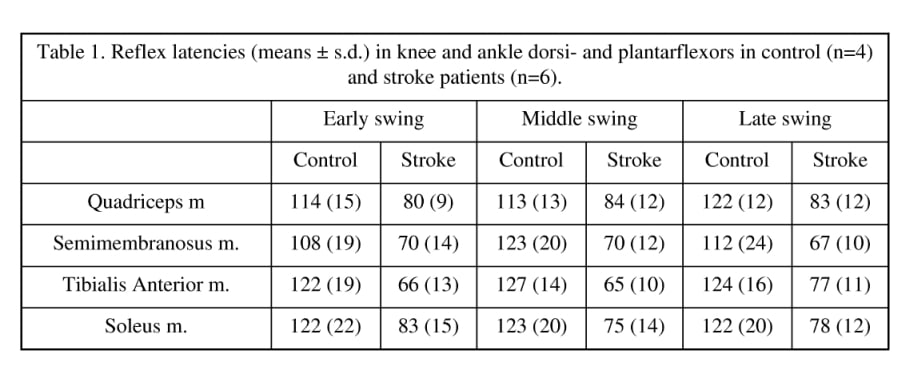During the swing phase of walking, duration ~ 400 ms, a very repeatable pattern of angular velocity with minimal muscle activation is seen in lower limb joints. Earlier work showed (i) medium latency responses to a velocity perturbation in silent muscles (Garrett & Luckwill, 1983) and (ii) reduced extensor monosynaptic reflex inhibition during swing in stroke patients (Garrett & Caulfield, 2001). Our objective was to compare corrective responses to velocity perturbation in walking in intact individuals and stroke patients. Electromyographic activity of knee and ankle flexors and extensors and kinematic data from hip, knee and ankle using 3D opto-electronic gait analysis system (CODA) were simultaneously recorded from individuals with unilateral cerebral stroke (n=6; age 58-78) and control subjects (n=4; age 5573) during a period of treadmill walking. An unexpected resistance to the affected leg in stroke and the right leg in controls (Garrett & Luckwill, 1983) was triggered at early (0-25%), middle (25-50%) and late (50-75%) swing phase. Five recordings were made in each phase.TableThe latencies in stroke patients were very significantly shorter (t two-tail <=1.69E-10 to t<=6.00E-10) than those seen in intact individuals. Great consistency was observed in reflex latencies in each muscle at all periods of swing within each group. Reflex latencies in all muscles tested were virtually identical within each group. Stroke patients only showed a positive correlation (r=0.65) at midswing between latencies in the ankle plantar and dorsiflexor muscles. Control subjects only showed a negative correlation (r=-0.49) in late swing between reflex latencies in the hamstrings and soleus muscles. The consistency of reflex latencies within both groups suggests involvement of the same afferent feedback. Reflex latencies do not appear to be primarily determined by the length of the reflex pathway nor by timing within swing. The relationships observed between reflex latencies differ for stroke and intact individuals but may involve changes in monosynaptic reflex modulation in stroke.
University of Glasgow (2004) J Physiol 557P, C60
Communications: Reflex response latencies to afferent feedback from velocity perturbation during walking in stroke patients and controls.
M. Garrett and A. Varghese
Physiotherapy, University College Dublin, Dublin 7, Ireland
View other abstracts by:
Where applicable, experiments conform with Society ethical requirements.

